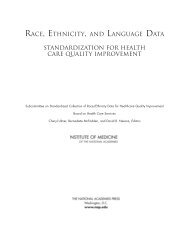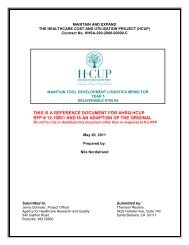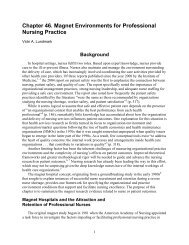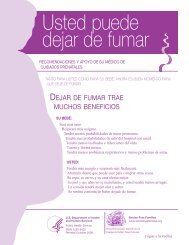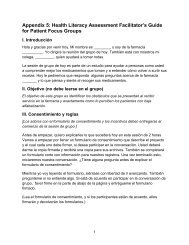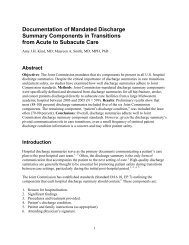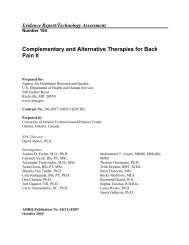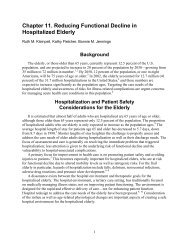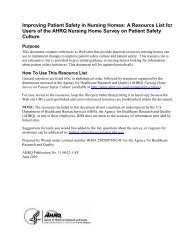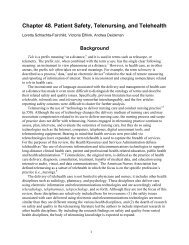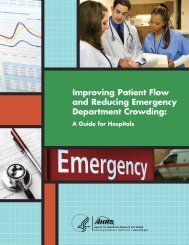Emergency Severity Index (ESI): A Triage Tool for Emergency ...
Emergency Severity Index (ESI): A Triage Tool for Emergency ...
Emergency Severity Index (ESI): A Triage Tool for Emergency ...
Create successful ePaper yourself
Turn your PDF publications into a flip-book with our unique Google optimized e-Paper software.
Chapter 6. Use of the <strong>ESI</strong> <strong>for</strong> Pediatric <strong>Triage</strong><br />
Pediatric <strong>Triage</strong> Assessment<br />
<strong>Triage</strong> Assessment: What Is Different<br />
<strong>for</strong> Pediatric Patients?<br />
The goal of the triage nurse is to rapidly and<br />
accurately assess an ill child in order to assign a<br />
triage level to guide timely routing to the<br />
appropriate emergency department area <strong>for</strong><br />
definitive evaluation and management. <strong>Triage</strong> is not<br />
a comprehensive assessment of the pediatric patient.<br />
The <strong>ESI</strong> version 4 requires that the triage nurse<br />
follow the same algorithm on all patients, pediatric<br />
and adult. While the algorithm is the same<br />
regardless of age, the decision process in the<br />
pediatric patient must take into account agedependent<br />
differences in development, anatomy,<br />
and physiology.<br />
The triage nurse needs a good sense of what<br />
constitutes “normal” <strong>for</strong> children of all ages. This<br />
knowledge will make it easier to recognize things<br />
that should be concerning (e.g., the 6-month-old<br />
who is not interested in his or her surroundings or<br />
the 2-week-old who is difficult to arouse to feed).<br />
The triage nurse must be com<strong>for</strong>table interacting<br />
with children across the age spectrum and must be<br />
well versed in the anatomic and physiologic issues<br />
that may put a child at increased risk, as well as<br />
certain age-dependent “red flags” that should not be<br />
overlooked. The importance of adequate education<br />
in pediatrics prior to undertaking the triage of<br />
pediatric patients cannot be overemphasized. The<br />
following are key points that the triage nurse should<br />
keep in mind when assessing a child:<br />
1. Use a standardized approach to triage assessment<br />
of the pediatric patient, such as the 6-step<br />
approach described in the next section. Observe<br />
skin color, respiratory pattern, and general<br />
appearance. Infants and children cannot be<br />
adequately evaluated through layers of clothing<br />
or blankets.<br />
2. Infants must be observed, auscultated, and<br />
touched in order to get the required in<strong>for</strong>mation.<br />
Their caregivers are critical to their assessment.<br />
Using a warm touch and a soft voice will help<br />
with the assessment.<br />
3. Infants over about 9 months of age and toddlers<br />
often have a significant amount of “stranger<br />
anxiety.” Approaching them in a nonthreatening<br />
manner, speaking quietly, getting<br />
down to the child’s eye level, and allowing them<br />
42<br />
to have a trusted caregiver with them at all times,<br />
will make the assessment easier. Allowing the<br />
child to remain on the caregiver’s lap and<br />
enlisting that person’s help in things like<br />
removing clothing and attaching monitors can<br />
help ease the child’s fears.<br />
4. Elementary school age and older children can<br />
usually be relied on to present their own chief<br />
complaint. Some preschoolers may have the<br />
verbal skills necessary to do so, but many do not<br />
or are simply too shy or frightened. In these<br />
cases, the chief complaint and other pertinent<br />
in<strong>for</strong>mation must be ascertained from the child’s<br />
caregiver.<br />
5. When assessing school-aged children, speak with<br />
them and then include the caregiver. Explain<br />
procedures immediately be<strong>for</strong>e doing them. Do<br />
not negotiate.<br />
6. Don’t mistake an adolescent’s size <strong>for</strong> maturity.<br />
Physical assessment can proceed as <strong>for</strong> an adult,<br />
remembering that they may be as afraid as a<br />
smaller child and have many fears and<br />
misconceptions. Pain response may be<br />
exaggerated.<br />
7. The signs of severe illness may be subtle and<br />
easily overlooked in the neonate and young<br />
infant. For example, poor feeding, irritability, or<br />
hypothermia are all reasons to be concerned in<br />
an otherwise well appearing neonate.<br />
8. Cardiac output in the infant and small child is<br />
heart-rate dependent—bradycardia can be as<br />
dangerous if not more dangerous than<br />
tachycardia.<br />
9. Infants, toddlers, and preschoolers have a<br />
relatively larger body surface area than their<br />
adult counterparts. This puts them at increased<br />
risk <strong>for</strong> both heat and fluid loss. This is<br />
compounded in the neonate, who does not have<br />
the fully developed ability to thermoregulate.<br />
These patients should not be kept undressed any<br />
longer than absolutely necessary and should<br />
have coverings replaced after a specific area is<br />
examined.<br />
10.Hypotension is a late marker of shock in<br />
prepubescent children. A hypotensive child is an<br />
<strong>ESI</strong> level 1, requiring immediate life-saving<br />
intervention.<br />
11.Weights should be obtained on all pediatric<br />
patients in triage or treatment area. The actual,<br />
not estimated, weight (in kilograms) is important



